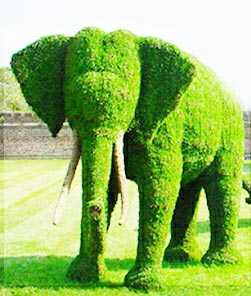Landscape Garden: Guide for making your own Topiary garden
Planning a Landscape Garden or topiary? Outdoor topiaries in your garden can give a striking effect to the surroundings.
 Creating topiary in your garden can make the place a focal point as well as can give a classy look. Topiary garden is nothing but a horticulture art of cultivating live perennial plants by clipping the foliage or the twigs of trees, shrubs and other plants to portray the clearly defined shapes and figurines. Topiaries were a Roman plant art and were first introduced in Roman gardens and villas. Apparently, this plant form spread to many other countries like China, Japan and other European countries. Topiaries are one of the best garden décor.
Creating topiary in your garden can make the place a focal point as well as can give a classy look. Topiary garden is nothing but a horticulture art of cultivating live perennial plants by clipping the foliage or the twigs of trees, shrubs and other plants to portray the clearly defined shapes and figurines. Topiaries were a Roman plant art and were first introduced in Roman gardens and villas. Apparently, this plant form spread to many other countries like China, Japan and other European countries. Topiaries are one of the best garden décor.
Plants used in the topiary art
 The types of plants which are used in the topiary art are the evergreen plants which are little shrubs, trees, grasses, woody plants, needled leaves and other foliage. The typical trees used for topiary forms are bay laurel, arborvitae, holly, myrtle and privet. The traditional topiary art is a little different from the contemporary topiary form. The modern topiary form makes use of cages and wires in order to guide the plant growth and the traditional topiary involves a method wherein a lot of patience and steady hands are required.There are three kinds of topiaries;
The types of plants which are used in the topiary art are the evergreen plants which are little shrubs, trees, grasses, woody plants, needled leaves and other foliage. The typical trees used for topiary forms are bay laurel, arborvitae, holly, myrtle and privet. The traditional topiary art is a little different from the contemporary topiary form. The modern topiary form makes use of cages and wires in order to guide the plant growth and the traditional topiary involves a method wherein a lot of patience and steady hands are required.There are three kinds of topiaries;
- Vine topiary: In this art of planting, vines are encouraged and shaped to grow in various topiary forms
- Shrub topiary: This art of planting consists of various shrubs which are designed in various shapes and sizes.
- Moss topiary: In this method you have to fill in a topiary form with wet moss and the chosen plant and water it accordingly.
Topiary Garden in India
 Samban-Lei Sekpil, a flowering shrub use for fencing gardens in Manipur, is the world’s tallest topiary at Guinness Book of Records.
Samban-Lei Sekpil, a flowering shrub use for fencing gardens in Manipur, is the world’s tallest topiary at Guinness Book of Records.- Topiary Park Chandigarh located in Sector-35 most popular park among the children with better playing facilities.
Tips to create topiaries in your balcony or garden
Get the topiary forms: The first important step for you to create topiary in your garden or balcony is to get your desired topiary form. There are various stores and online sites where you can have a look at the topiary form and buy them. Apart from just the frames you can also have an easy form of topiary by getting a moss topiary or readymade garden sculpture. The topiary forms are available in wide variety consisting of animal shapes, sea animals, attractive figurines and patterns.
Choose your desired plant: The next step would be to choose the plant which you have selected to convert into a topiary form. This activity depends on what you want to design topiary from like a vine, a tree or moss.
 For moss topiary: If you want a moss topiary, you can go in for sphagnum moss by soaking it in a bucket of water for 15-20 minutes. It has to be completely saturated and should be like a sponge. Once you have soaked the moss, squeeze the excess water and fill it in the topiary. Once you have done filling the topiary form with the wet moss, you should tie the structure with a nylon line for the moss to stay in place. Once you have filled in the moss in the structure, you have to make hole for the selected plant. Fill in the structure with different rooted plants and make use of topiary pins and hair pins to secure them. Water it regularly and use an apt fertilizer along with a regular trim. Make sure that the plant stays in shape.
For moss topiary: If you want a moss topiary, you can go in for sphagnum moss by soaking it in a bucket of water for 15-20 minutes. It has to be completely saturated and should be like a sponge. Once you have soaked the moss, squeeze the excess water and fill it in the topiary. Once you have done filling the topiary form with the wet moss, you should tie the structure with a nylon line for the moss to stay in place. Once you have filled in the moss in the structure, you have to make hole for the selected plant. Fill in the structure with different rooted plants and make use of topiary pins and hair pins to secure them. Water it regularly and use an apt fertilizer along with a regular trim. Make sure that the plant stays in shape.
For a vine topiary: Choose the English ivy which is the common vine used in topiary forms. Apart from this you can also use vinca minor and Boston ivy for your topiary form. Vine topiaries grow faster and are tolerant to any weather condition. They also give an elegant look to your garden.
For shrubs: If you are confident about making topiary without a topiary frame, you can go ahead with it by using a shrub. It is advisable that you have a frame as it will be easier for you to shape the plant. Shrubs like Dwarf Burford Holly, Eugenia, Compacta Holly, Rosemary and other are apt for topiary forms.
Few of the apt topiary plants are;
 Chilean guava
Chilean guava- Oandarin ‘Thorny’
- Feijoas
- Camellia ‘Setsugekka’
- Corokia ‘Cappuccino’
- Golden totara
- Kowhai
- Port Wine oagnolia
- Silver Germander
- Australian frangipani Fruiting
Shaping your topiary
 This art requires a lot of patience and hard work. You need not fret if you are rearing your topiary in a frame. But if you have chosen to design topiary without a frame, you will have to make use of shrubs and cultivate them till they grow to a good height. Choose a shape and start pruning them. The most commonly used shapes are spirals, domes, pyramid, balls and cubes. Once the shrub grows up to 4 feet tall, you can start pruning and shaping it. Although sculpting takes lot of time, you need to be careful and ensure that the plant is sculpted in shape.
This art requires a lot of patience and hard work. You need not fret if you are rearing your topiary in a frame. But if you have chosen to design topiary without a frame, you will have to make use of shrubs and cultivate them till they grow to a good height. Choose a shape and start pruning them. The most commonly used shapes are spirals, domes, pyramid, balls and cubes. Once the shrub grows up to 4 feet tall, you can start pruning and shaping it. Although sculpting takes lot of time, you need to be careful and ensure that the plant is sculpted in shape.
Keep pruning your topiary forms to retain their shape
After a hard work you see the designed topiary form. If it is a potted topiary form or is raised on the ground, you should make sure that you water it regularly along with a proper fertilization. Topiary can also be cultivated in large pots, ceramic and plastic containers. It is very important that you have to keep pruning your topiary forms in order to retain their shape. The tools can vary depending on your choice from scissors to shears. You should view the topiary from all the angles once you start pruning to get a better shape.
Perhaps if you find that rearing topiary is quite a hassle, you can always decorate your home with readymade topiary forms. The topiary forms in the market are available for Rs.1500.
Read related articles
Home Garden: Design your miniature garden
Tips for Lawn Maintenance
Ideas for garden decorations









